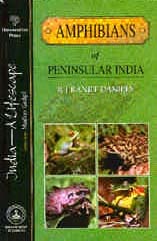
Amphibians of Peninsular India
K. V. GURURAJAEnergy and Wetlands Research Group, Centre for Ecological Sciences,
Indian Institute of Science, Bangalore 560 012, India
e-mail: gururaj@ces.iisc.ac.in

 |
Amphibians of Peninsular India K. V. GURURAJAEnergy and Wetlands Research Group, Centre for Ecological Sciences, Indian Institute of Science, Bangalore 560 012, India e-mail: gururaj@ces.iisc.ac.in |
 |
 Amphibians of Peninsular India. R. J. Ranjit Daniels. Universities Press (India) Pvt Ltd, 3-5-819, Hyderguda, Hyderabad 500 029. 2005. 268 pp. Frogs and toads have always fascinated man through the ages, dating back to Mandukya Upanishad of the Vedic ages to the recent discoveries in the Western Ghats. More technically known as ‘amphibians’ (Greek equivalent for their biphasic life stages as tadpoles and adults), these include caecilians, salamanders, newts, and sirens. Amphibians are in serious scientific contention over the last decade for at least two main reasons. One being far more crucial, pertaining to their viable existence as there are alarming indications of decline in their global population, and the other on the frequent discoveries from biodiversity hotspot regions like Sri Lanka and the Western Ghats of India, emphasizing the linkages of phylogeography, evolution, etc. This book by Daniels, has landed in the stands at a right time, when more and more researchers are getting into the field of herpetology with a fewer number of experienced researchers remaining in it (or at least in this part of the globe). Indeed the book is a much-awaited one on amphibians, as the author did write a series of field identification papers in Cobra during 1997, which were again an exceptional attempt in that period. In popularizing the subject, the structure and contents of the book are good and come out of the vast experiences and indepth knowledge of the author in amphibian research. As the author himself admits, this book is written keeping in mind the students and amateur naturalists. It probes and compels the young minds into the field of research, especially while dealing with the suggested students’ projects. Such an approach by a senior researcher highlights the openness of the author about the subject and also emphasizes the current research attitude that requires more openness to share information (more so to the younger generation). All the chapters have been written in a crisp and lucid manner, and are certainly not loaded with details on anatomy, physiology and developmental biology, etc. of typical subject books, but have instead provided what is relevant to present-day research in the field. Suggested reading provides ample scope to the reader to go beyond the book. Keys to the species have been dealt with nicely with the inclusion of related taxa, life history, local names and remarks along with field characters, diagnostic features, habits, habitats and distribution. This has encompassed almost all the information pertaining to field identification of a species, which was earlier more fragmented pieces of information. Though the book does lack the unique style of the author, which was prevalent in his earlier papers and books, it is more lucid. A few typographical errors (e.g. in p. 4, Rhinametridae, instead Rhinatrematidae) still persist in the book. Combining various existing names with their synonyms has added more confusion than the purpose for which it was written. As an example, the species account of Hoplobatrachus tigerinus has been detailed in p. 188. The synonyms of this species include Rana malabarica, which is a separate species by itself. This will lead to identity conflict of the species, as there is a separate description of Rana malabarica on p. 233. One might think that H. tigerinus and R. malabarica are the same species with two different names, which in a real sense is not true. The title for the sketches is really cumbersome and lists many common names (similar to that of synonyms as mentioned earlier). Instead of listing, the single name with its nomenclature have been sufficient. Some of the sketches of amphibian species that seem to be computer morphing of colour photographs into black and white, do not reveal much about the species. This could have been substituted with photographs that would aid in easy identification. Similarly, sketches of tadpoles along with the adult without relative sizes does not seem to help students in the field, as the tadpoles grow in the beginning (increase in size) and undergo retrogressive metamorphosis (reduced size) before turning into adults. This is more evident in the tadpole sketches of Rana curtipes, Rana aurantiaca, Nyctibatrachus major and Euphlyctis hexadactylus. I do personally agree that when the live specimen is photographed, it is difficult to keep a scale, and moreover this will tarnish the reality of the picture. But as the intention of the book is to make both students as well as amateurs alike identify the amphibian, sketches without relative size hardly serve the purpose. The femoral glands in N. major are sketched closer to the groin; in reality it is further below and near the vent portion. Even such a minor error has great impact during field identification. Good quality photographs are the best part of the book (except one from the author on Euphlycitis cyanophlyctis); however, they stand completely isolated without any linkages to the text part. Inclusion of glossary of terminology would have been an added advantage to students. Distribution information would have been more impressive if it had maps of peninsular India. A sentence about trap stealing in the field has stressed the extremities one might face in the field conditions. At the same time bringing in India into the issue may not have been right, especially when nationality and national pride are serious issues in young minds. Such sentences could have been avoided by the author. There is no doubt that this book will go a long way as a pioneering field guide to the amphibians in the peninsular region and will be a recommended copy for both students and amateurs.
|